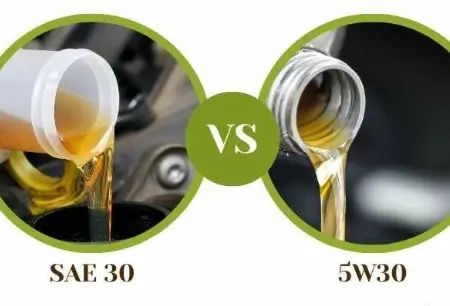Yes, you can use 5W30 instead of SAE 30 for your vehicle. With its higher viscosity, SAE 30 is commonly recommended for warmer temperatures, while 5W30 is suitable for a wider range of temperatures.
This makes 5W30 a more versatile option that can provide better engine protection in various weather conditions. It is important to consult your vehicle’s manual or a professional mechanic for specific recommendations and ensure compatibility with your engine. By using 5W30, you can potentially improve your engine’s performance and prolong its lifespan, especially if you regularly drive in different climate conditions.
Understanding The Difference Between 5w30 And Sae 30
Understanding the Difference Between 5W30 and SAE 30
When it comes to choosing the right engine oil for your vehicle, it’s essential to understand the various specifications and terminologies associated with different oil types. Two commonly used engine oils are 5W30 and SAE 30. While they may seem similar, they have distinct differences that can affect the performance and longevity of your engine.
What Does 5w30 And Sae 30 Mean?
Both 5W30 and SAE 30 are viscosity grades that indicate the thickness or flow resistance of the oil under different temperature conditions. The numbers here represent the viscosity ratings, and each rating has a specific meaning.
The “W” in 5W30 stands for “winter,” indicating that this oil has been formulated to provide adequate lubrication during cold weather conditions. The number 5 before the W indicates the oil’s viscosity at low temperatures, where it needs to be thin enough to flow smoothly through the engine even in freezing temperatures.
On the other hand, SAE 30 is a single-grade oil, meaning it has a fixed viscosity rating at a standard temperature. In the case of SAE 30, the viscosity rating represents the oil’s resistance to flow at around 100 degrees Celsius or 212 degrees Fahrenheit.

How Are They Different In Terms Of Viscosity?
The key difference between 5W30 and SAE 30 lies in their viscosity at varying temperatures. 5W30 has a lower viscosity at low temperatures compared to SAE 30.
Thanks to its formulation, 5W30 can flow more easily during cold starts, providing the necessary lubrication to protect engine components against wear and tear, especially during cold weather conditions. This is why it’s commonly recommended for vehicles operating in regions with colder climates.
On the other hand, SAE 30 has a higher viscosity and works better at higher temperatures. It maintains its thickness and provides sufficient lubrication in warmer climates or during prolonged periods of high engine temperature. However, it may not flow as smoothly during cold starts, which can affect the initial lubrication of engine components.
Importance Of Viscosity In Engine Oil Selection.
Viscosity plays a crucial role in proper engine oil selection. It determines how effectively the oil can lubricate engine components and protect them from friction, heat, and wear. Using an oil with the wrong viscosity can lead to various issues, including decreased fuel efficiency, reduced engine performance, and potential engine damage.
When selecting engine oil, it’s vital to consider the manufacturer’s recommended viscosity grade for your vehicle. This information can be found in the owner’s manual or by consulting with a trusted mechanic. Adhering to the recommended viscosity ensures the oil will maintain its protective properties and keep your engine running smoothly under normal operating conditions.
Factors To Consider When Choosing The Right Engine Oil
Choosing the right engine oil is crucial for maintaining the performance and longevity of your vehicle’s engine. With so many options available, it can be overwhelming to know which type of oil is the best fit for your engine. In this blog post, we will discuss the factors that you should consider when choosing engine oil and highlight the importance of understanding manufacturer recommendations. So, before you reach for that bottle of 5W30 instead of SAE 30, let’s dive into the key factors you need to keep in mind.
How To Determine The Recommended Oil Type For Your Engine?
When it comes to determining the recommended oil type for your engine, there are a few important factors to consider. These include:
- Vehicle Make and Model: Different vehicles have different oil recommendations based on their design and engine specifications. It’s crucial to consult your vehicle’s owner’s manual to determine the oil type recommended by the manufacturer.
- Operating Conditions: The operating conditions under which your vehicle is used also play a significant role in determining the right oil type. For instance, if you frequently drive in extreme temperatures or engage in heavy towing or hauling, you may need to opt for an oil with a higher viscosity.
- Oil Performance Ratings: Engine oils are rated based on their viscosity, indicated by numbers such as 5W30 or SAE 30. The viscosity rating determines how the oil flows at different temperatures. It’s crucial to understand these ratings and choose an oil that matches your engine’s requirements.
Understanding The Manufacturer’s Specifications And Recommendations
Maintaining your engine’s warranty and optimizing its performance often requires adhering to the manufacturer’s specifications and recommendations. The manufacturer spends countless hours testing and researching the engine to determine the most suitable oil type for optimal performance and longevity. Deviating from these recommendations can potentially lead to significant engine damage and void your warranty.
Keep in mind that manufacturers specify oil types considering factors such as engine materials, temperature ranges, and lubrication requirements. Trusting their expertise and adhering to their recommendations is crucial for the overall health of your engine.
The Impact Of Using The Wrong Engine Oil On Engine Performance And Longevity
Using the wrong engine oil can have detrimental effects on both engine performance and longevity. Here are a few key impacts to consider:
- Poor Lubrication: Different engines have different lubrication requirements, and using the wrong oil can lead to inadequate lubrication, resulting in increased friction and wear. This can lead to premature engine failure and costly repairs.
- Decreased Fuel Efficiency: Using the wrong oil can lead to increased friction and reduced engine efficiency, resulting in decreased fuel economy. Over time, this can significantly impact your overall fuel costs.
- Reduced Engine Lifespan: The wrong oil can put excessive strain on your engine, causing it to work harder and experience increased wear and tear. This can shorten the overall lifespan of your engine and require premature replacements.
To ensure optimum engine performance and longevity, always prioritize using the recommended engine oil type specified by the manufacturer. By doing so, you’ll be taking proactive steps to protect your investment and keep your engine running smoothly for years to come.
The Pros And Cons Of Using 5w30 Instead Of Sae 30
If you’re wondering whether you can use 5W30 instead of SAE 30 oil in your vehicle, it’s important to weigh the pros and cons. While both types of oil have their benefits and drawbacks, understanding how they differ can help you make an informed decision for your specific needs. In this article, we’ll delve into the advantages and disadvantages of using 5W30 instead of SAE 30, shedding light on factors such as cold weather performance, compatibility with newer engine technologies, oil consumption and leaks, and high-temperature protection. Let’s explore each of these aspects in more detail.
Advantages Of Using 5w30 In Certain Situations.
When it comes to improved cold weather performance, 5W30 oil has a significant advantage over SAE 30. The “5W” in its name indicates that it has a lower viscosity at low temperatures compared to SAE 30. This means that it flows more easily during cold starts, reducing engine wear and allowing for faster lubrication. If you live in a region with extremely cold winters or frequently face sub-zero temperatures, using 5W30 can provide you with peace of mind and smoother engine operation.
In addition, 5W30 oil is designed to be compatible with newer engine technologies. As engines continue to evolve, manufacturers have developed advanced systems such as variable valve timing, turbocharging, and direct injection. These technologies require an oil that can perform optimally, and 5W30 meets those requirements. By using this oil, you ensure that your engine’s components are well protected and can operate at their full potential, maximizing performance and longevity.
Disadvantages Of Using 5w30 In Certain Situations.
Despite its advantages, using 5W30 instead of SAE 30 oil may have some disadvantages worth considering. One potential drawback is increased oil consumption and the likelihood of leaks. Due to its lower viscosity, 5W30 oil tends to be thinner. While this is beneficial for cold weather performance, it also means that it may flow more easily through worn seals or gaskets, leading to oil leaks. Additionally, the thinner consistency can result in higher oil consumption, as some of it may be burned off during the combustion process. If your vehicle already experiences oil leaks or high oil consumption, it’s important to weigh these potential issues.
Another disadvantage of using 5W30 oil is reduced high-temperature protection. The “5W” part of the oil’s name indicates its viscosity at low temperatures, but it also means that it has a higher viscosity at high temperatures compared to SAE 30. In environments with consistently high temperatures or when operating under heavy loads, the oil may thin out faster, reducing its ability to provide adequate protection to engine components. If your vehicle is regularly subjected to high temperatures or extreme driving conditions, consider whether the reduced high-temperature protection of 5W30 oil is worth the trade-off.

Credit: www.amazon.com
Instances Where Using 5w30 Instead Of Sae 30 Is Acceptable
Choosing the right type of motor oil for your vehicle is essential for optimal performance and engine longevity. While SAE 30 oil has been the traditional choice for older engines, there are certain instances where using 5W30 as a substitute is acceptable. In this article, we will explore recommended scenarios for using 5W30, particularly in modern vehicles with multi-viscosity oil requirements, extreme cold weather conditions, and older engines in need of improved cold start performance.
Recommended Scenarios For Using 5w30 As A Substitute
Modern vehicles with multi-viscosity oil requirements
Modern vehicles often come with manufacturer recommendations for using multi-viscosity oil, such as 5W30. This type of oil provides better protection across a wider range of temperatures, making it suitable for both cold starts and high-temperature conditions. Additionally, multi-viscosity oils can offer improved fuel efficiency and reduced engine wear, which is beneficial for maintaining the performance of your vehicle.
Extreme cold weather conditions
In regions where frigid temperatures are a regular occurrence, using 5W30 instead of SAE 30 can be advantageous. The “W” in 5W30 stands for winter, indicating that the oil has a lower cold-temperature viscosity. This means that the oil remains fluid and flows more easily during cold starts, providing better lubrication to critical engine parts. By using 5W30 in extreme cold weather conditions, you ensure that your engine is adequately protected, reducing the risk of damage from insufficient lubrication.
Older engines in need of improved cold start performance
For older engines that may struggle with cold starts, switching to 5W30 can help improve their performance. The lower cold-temperature viscosity of 5W30 enables easier flow during start-up, reducing the strain on the engine components and promoting smoother operation. Older engines often suffer from increased friction and wear, and using 5W30 provides better protection during these crucial moments when the engine is just coming to life.
While these scenarios provide acceptable instances for using 5W30 instead of SAE 30, it’s important to consult your vehicle’s owner’s manual or seek advice from a qualified professional to ensure you select the right oil viscosity for your specific engine and driving conditions.
Instances Where Using Sae 30 Is Necessary
While 5W30 may be suitable for many engines, there are certain situations where using SAE 30 is necessary due to specific requirements and operating conditions. In this section, we will explore the instances where SAE 30 is the preferred option, including specific manufacturer recommendations, high-temperature operating conditions, and vintage or classic engines with specific oil requirements.
Situations Where Sae 30 Is The Preferred Option
In certain situations, using SAE 30 oil is not just a recommendation, but a requirement. These include:
- Engines with clear manufacturer recommendations for SAE 30 oil
- High-temperature operating conditions
- Vintage or classic engines with specific oil requirements
Specific Manufacturer Recommendations
Many engine manufacturers specify the use of SAE 30 oil in their engines. It is important to follow these recommendations to ensure optimal performance and longevity of the engine. Failure to use the recommended oil viscosity can result in inadequate lubrication, increased friction, and potential damage to engine components. Always refer to the manufacturer’s guidelines or consult with a qualified mechanic before deviating from their recommendations.
High-temperature Operating Conditions
Engines that operate in high-temperature environments, such as those found in hot climates or heavy-duty applications, may require the use of SAE 30 oil. This is because SAE 30 oil has a higher viscosity compared to 5W30, allowing it to maintain proper lubrication and reduce wear and tear under extreme heat. In these conditions, using a thinner oil like 5W30 may result in oil breakdown and reduced engine protection.
Vintage Or Classic Engines With Specific Oil Requirements
Vintage or classic engines often have more specific oil requirements due to their design and age. These engines may have tighter clearances and different metallurgy compared to modern engines, requiring the use of SAE 30 oil. The higher viscosity of SAE 30 oil provides the necessary film strength and protection for these older engines. Using a different oil viscosity, such as 5W30, may result in poor engine performance, increased oil consumption, and potential damage.
The Verdict: 5w30 Vs Sae 30
Discover the verdict on whether you can use 5W30 instead of SAE 30 oil. Gain insights into their differences and make an informed decision for your vehicle’s optimal performance. Choose wisely for the right engine lubrication and efficiency.
Summarizing The Key Points Discussed
Now that we’ve explored the differences between 5W30 and SAE 30 oils, let’s summarize the key points discussed:
- 5W30 is a multi-grade oil that offers better engine protection in cold temperatures compared to SAE 30.
- SAE 30 is a single-grade oil that provides better protection against high-temperature breakdowns.
- The choice between 5W30 and SAE 30 depends on the climate and operating conditions your engine will encounter.
- If you live in a cold climate where temperatures frequently drop below freezing, 5W30 is recommended to ensure easy engine startup and lubrication.
- For engines operating in hot climates or under heavy loads, SAE 30 may be the better choice to provide adequate protection against viscosity breakdown.
- Consulting your vehicle’s manufacturer recommendations and considering the specific needs of your engine is crucial in making an informed decision.
Understanding The Trade-offs And Considerations
While both 5W30 and SAE 30 have their advantages, it’s essential to understand the trade-offs and considerations:
- 5W30 may result in a slight reduction in fuel economy due to its lower viscosity at operating temperatures.
- SAE 30 might not flow as well in cold conditions, leading to potential engine damage during startup.
- Choosing the right oil viscosity ensures proper lubrication and keeps your engine running smoothly.
- Consider the climate, driving conditions, and manufacturer recommendations when deciding between 5W30 and SAE 30.
- Regular oil changes are crucial regardless of the type of oil you choose to maintain optimal engine performance.
Making An Informed Decision Based On Your Specific Needs And Circumstances
When it comes to choosing between 5W30 and SAE 30, it’s important to make an informed decision based on your specific needs and circumstances:
- The climate you live in and the temperature ranges your engine will experience.
- The type of driving you do, such as short trips or long highway journeys.
- If your vehicle’s manufacturer has provided any specific recommendations or requirements.
By considering these factors and understanding the trade-offs between 5W30 and SAE 30, you can make the best decision for your engine’s longevity and performance.
Frequently Asked Questions For Can I Use 5w30 Instead Of Sae 30
Can I Use 5w30 Instead Of Sae 30?
Yes, you can use 5W30 instead of SAE 30 in most cases. Both oils are suitable for moderate temperatures, but 5W30 offers better cold-start protection. However, always consult your vehicle’s manual to ensure compatibility and follow the manufacturer’s recommendations for optimal engine performance and longevity.
Conclusion
Using 5W30 instead of SAE 30 is generally a feasible option for your vehicle. While both oils have similar viscosities, it’s important to consider the manufacturer’s recommendations and the specific needs of your engine. Always consult your owner’s manual or a professional mechanic for guidance.
Ultimately, ensuring the proper oil is used can help maintain optimal engine performance and longevity.


Leave a Reply